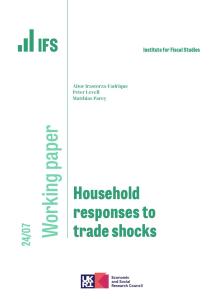The gender composition of those staying in education beyond school leaving age has been one of the most dramatic changes in education over the last 50 years: from a situation of significant under-representation, girls took 22% more A levels than boys this year and are over a third more likely to go to university. Indeed, these gaps are now so large that the under-representation of men in higher education – especially those from poorer white families – has become a topic of significant policy interest in recent years.
Yet against this backdrop of female success, there remain areas in which women are significantly under-represented. The A level results released last week confirmed that girls are still less likely to take STEM (science, technology, engineering and maths) A levels than boys: despite receiving 55% of A levels overall this year, girls received just 43% of A levels awarded in STEM subjects. This is not the case for all STEM subjects: girls are just as likely as boys to take chemistry, and more likely to take biology. The most striking gaps are in physics and maths: girls accounted for 39% of this year’s maths A levels, 28% of further maths A levels, and just 22% of all physics A levels.
This matters because these A levels are important routes into studying STEM subjects at university and into STEM careers: an under-representation of women in maths and physics at A level leads to an under-representation of women in careers that use these subjects. This is important for society – for example, some research suggests that workplace diversity can aid innovation. These choices also matter for the individuals themselves: having a maths A level appears to bring financial rewards in the labour market, and both subjects can open doors to potentially lucrative university degrees. For example, recent IFS research suggests that, compared to the average female graduate five years after graduation, women with a maths degree earn 13.4% more, those with an engineering degree earn 9.7% more, and those with an economics degree – another subject in which girls are significantly under-represented and for which maths is often a gateway subject – earn 19.5% more.
Explaining the gender gap in maths and physics
The fact that fewer girls study maths and physics at A level is not because they are less well prepared: attainment in maths and physics GCSE is very similar for girls and boys. Moreover, the gender gap in the likelihood of taking maths and physics A level is very similar if we focus only on students who achieved top grades at GCSE, and so are likely to be the best prepared for A level study. For example, among pupils who achieved grade A or A* (equivalent to grades 7-9 under the new system) in GCSE maths in 2010, 37% of girls compared to 51% of boys took maths A level. Among those who achieved grade A or A* in GCSE physics, just 13% of girls compared to 39% of boys took physics A level.
So why do so few girls choose to study maths and physics? As part of a pilot study for a new project investigating why girls are under-represented in maths and physics, funded by the STEM Skills Fund, we surveyed just under 300 girls across 40 schools who were predicted to achieve at least grade 7 (at least grade A) in either maths, physics or combined science at GCSE. We also surveyed their teachers. The aim was to understand what drives girls’ A level choices, including why they may or may not opt for maths or physics. These findings were summarised in a recent IFS report.
The gender gap in maths and physics does not seem to arise because girls don’t find maths and physics interesting, or because they don’t understand or value the prospects offered by a STEM career. So what else is going on? Confidence seems to be a big part of the issue, particularly when it comes to physics. We found that, despite their high predicted grades, about half of the girls in our sample agreed or strongly agreed with the statements “I often worry that it will be difficult for me in physics classes” or “I worry I will get poor grades in physics”. The figures were about half that for maths. Teachers also cited a lack of confidence as the biggest factor affecting the gender gap in pursuing STEM subjects to A level: 80% agreed or strongly agreed that “these girls are just as able, but not as confident in their ability to learn STEM subjects as boys.” This chimes with research by the OECD and others, suggesting that a lack of confidence amongst girls might be an important determinant of gender differences in attainment in STEM subjects or the decision to pursue STEM careers.
Perhaps more challenging from a policy perspective is the fact that being one of the only girls in a physics class at school or university, or indeed in a STEM job, seems to be a major factor putting off some girls. Two thirds of the girls we surveyed viewed STEM jobs as male dominated, and a similar proportion of teachers agreed or strongly agreed that “these girls don’t want to/feel discouraged from pursuing STEM subjects at A level because many of their female peers do not.” The fact that girls attending single-sex schools are more likely to study these subjects than girls in mixed-sex schools supports this idea.
Encouraging a critical mass of girls into STEM
This raises a tricky issue: if girls’ hesitations about studying and working in male-dominated environments are an important determinant of their decision not to study maths or physics at A level, then interventions that attempt to encourage one or two girls in a school to change their behaviour may not be enough. What may be required are interventions which send a strong signal to girls that not just they, but also a significant number of their peers, are being encouraged to pursue physics and maths. But even this alone may not be enough: after all, girls attending single sex schools are still less likely to take maths and physics than boys. So what is likely to work? That is exactly what we hope to explore in future research.
We acknowledge the funding from the European Research Council (ERC) under the European Union's Horizon 2020 research and innovation programme (grant agreement No 695300 - HKADeC - ERC-2015-AdG/ERC-2015-AdG)










